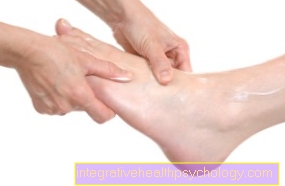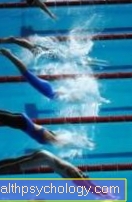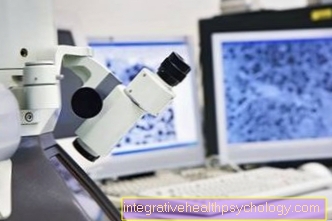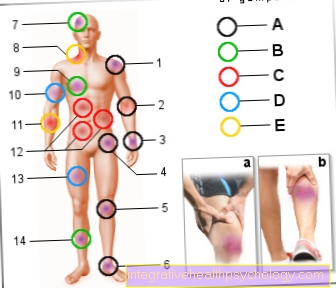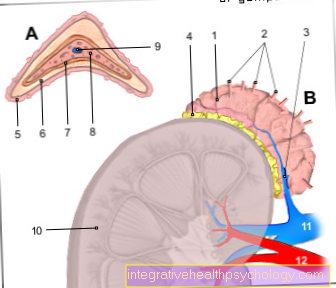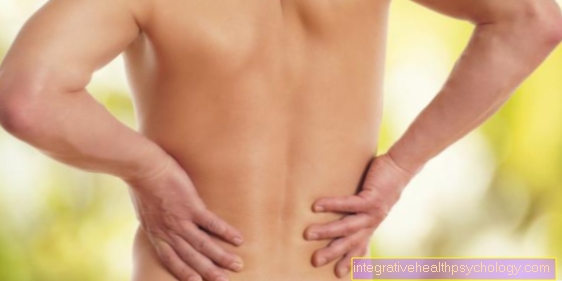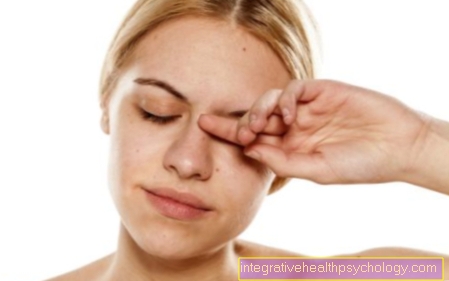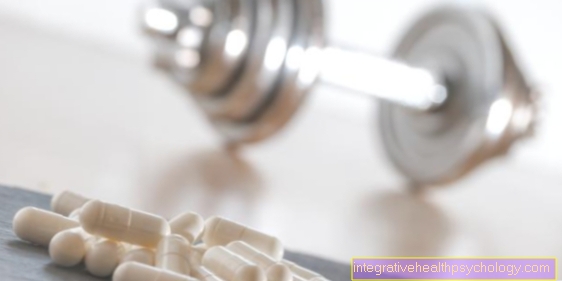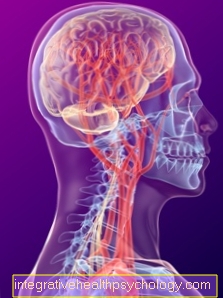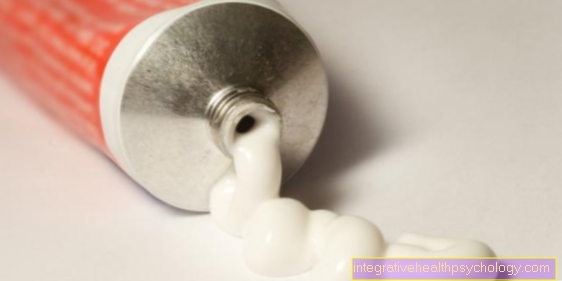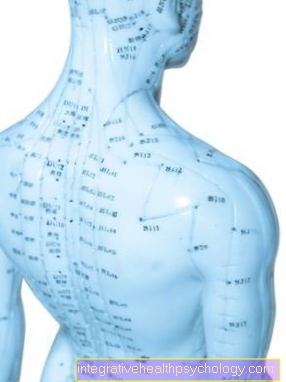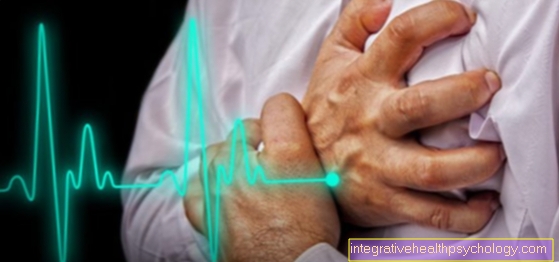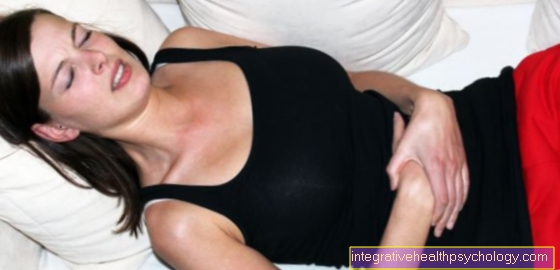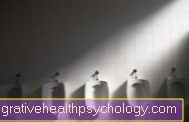Myogelosis
Introduction / definition
Myogelosis is a muscular hardening that can arise in different parts of the body for different reasons.
For general information, read at this point: What is muscle hardening?
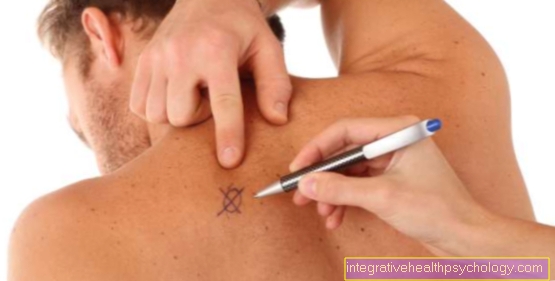
causes
Myogeloses arise from acute or chronic tension in the muscle area. In principle, myogelosis can occur wherever there are muscles. The most common cause of muscle tension is chronic stress, such as unilateral burdens.
People in sedentary professions are particularly at risk of stiff muscles.
In addition to improper loading of the shoulder area, improper loading of the legs or feet can also lead to myogelosis. A deficit that is not compensated for by shoe insoles or uneven walking can also lead to muscle hardening and tension in the long term.
Myogelosis on the shoulder blade
The shoulder blade and the entire shoulder region are one of the most common localizations of myogelosis. The reason for this is that monotonous movements in the arm area affect the shoulder particularly severely. Myogeloses in the shoulder area often radiate into the head. In the case of recurring headaches, myogelosis should always be considered as the cause.
Read more on the topic: Pain in the shoulder blade - these are the causes
Myogelosis on the chest
Myogelosis in the chest area is less common than in the shoulder area, but can lead to severe chest pain. Many patients report heart pain or chest pain. In any case, the heart should be examined as the triggering organ.
A typical cause of myogelosis, however, is movement-dependent pain without shortness of breath, which mainly starts between the ribs. There are numerous muscles between the ribs that can also harden and cramp and lead to persistent, severe, pulling or burning pain.
Appointment with a sports orthopedic specialist?

I would be happy to advise you!
Who am I?
My name is dr. Nicolas Gumpert. I am a specialist in orthopedics and the founder of .
Various television programs and print media report regularly about my work. On HR television you can see me every 6 weeks live on "Hallo Hessen".
As a passionate athlete, I have specialized in the treatment of sports diseases for professionals and hobby athletes.
The focus is therefore on diseases of the muscles, tendons and joints.
In order to be able to treat successfully in orthopedics, a thorough examination, diagnosis and a medical history are required.
In our very economic world in particular, there is too little time to thoroughly grasp the complex diseases of orthopedics and thus initiate targeted treatment.
I don't want to join the ranks of "quick knife pullers".
The aim of any treatment is treatment without surgery.
Which therapy achieves the best results in the long term can only be determined after looking at all of the information (Examination, X-ray, ultrasound, MRI, etc.) be assessed.
You can find me in:
- Lumedis - your orthopedic surgeon
Kaiserstrasse 14
60311 Frankfurt am Main
Directly to the online appointment arrangement
Unfortunately, it is currently only possible to make an appointment with private health insurers. I hope for your understanding!
Further information about myself can be found at Dr. Nicolas Gumpert
Myogelosis on the neck
Especially the area of the muscles in the cervical spine is affected by myogelosis. Here, too, bad posture is primarily responsible. Hours of PC work without relaxing movement exercises are the main trigger here.
Myogelosis of the cervical spine
In the case of myogelosis in the cervical spine area, the posterior or lateral neck or neck muscles are tense. Myogelosis is most common in these areas. Myogelosis of the cervical spine is often the result of poor posture. This bad posture can occur when sitting for long periods at work or while sleeping, for example when the head is too high due to too many pillows. The muscle hardening can also result from excessive stress caused by excessive sporting activity. In the neck and shoulder area, myogelosis can also arise, for example, in professions in which one-sided or monotonous movements are carried out, which heavily stress the shoulder, neck and throat muscles. For example, hairdressers or dentists, who often have a stooped posture, are often affected by myogelosis in the cervical spine and neck area.
More information on this topic can be found at: Pain in the cervical spine
However, myogelosis can also occur as a symptom of another underlying disease. So it does not occur rarely as a symptom of a cervical spine syndrome. The cervical spine syndrome is a collective term for various orthopedic and neurological symptoms in the neck, neck and arm area.
Read more on the topic: Symptoms of cervical spine syndrome
Posture errors are also possible causes. In addition to neck pain, other symptoms such as dizziness, headache, sensory disturbances in the arms or visual disturbances and ringing in the ears sometimes occur. Cold also not infrequently leads to myogelosis in the cervical spine area, as this causes the muscles to become tense. In some cases, psychological problems, emotional stress or protracted stress can also trigger myogelosis in the muscles of the neck and neck.
Trapezius myogelosis
The trapezius is often affected by myogelosis. It pulls from the upper spine to the shoulder and is important for lifting the arms over the shoulder and stabilizing the shoulder when carrying heavy loads. The trapezius is particularly stressed when working overhead and can cramp when overworked, which can lead to painful myogelosis. It is important to treat myogelosis in the trapezius, as the contracture or cramping causes the muscles to pull towards the head. This can cause tension on the humerus, which can lead to new problems, such as impingement syndrome.
Read more on the topic: Shoulder pain
Lumbar spine myogelosis
In most cases, myogelosis in the lower back is caused by poor posture, excessive strain and one-sided movements or strain on the back muscles. Myogelosis can also occur if there is a herniated disc in the lumbar spine. Since the herniated disc is much more common in the lumbar spine than in the neck or chest area, it is more often the cause of myogelosis in the lower back. In addition to shooting pain, other symptoms such as sensory disturbances (tingling, numbness) in the back and legs can occur. A doctor should then be consulted, as nerve damage can occur.
Read more on the topic: Herniated disc of the lumbar spine
Myogelosis in the calves
Muscle tension in the area of the lower legs and calves is more the result of excessive exercise and is usually indistinguishable from normal sore muscles. To avoid myogelosis, it is helpful to do warm-up exercises beforehand.
Symptoms
The first symptoms of myogelosis are pulling and pressing pain in the muscle area where the induration is present. The pain can also radiate from the actual area of origin and be perceived as pain at a completely different point in the body.
Headaches, for example, are very common, but these result from myogelosis in the shoulder area. The nerves that are irritated by a hardened muscle in the shoulder area transmit the pain to the forehead or temple region, which is perceived as a headache.
diagnosis
The diagnosis is usually made through the physical examination. Feeling the region of the body indicated as painful shows a clear hardening of the surrounding muscles. It is also very typical during the examination that the patient reports pain when touching.
In many cases, when touching the affected point, e.g. a painful pathway in the shoulder can be made clear (e.g. If the patient reports a pulling pain up to the head when touching a point in the shoulder). An imaging exam or blood test is usually not necessary to diagnose myogelosis.
therapy
Once myogelosis is diagnosed, a treatment plan should be drawn up for the patient. It is also important to ask what the patient does for a living, whether he does a sedentary job or a varied job, whether he does sport, whether he is stressed.
A good, non-drug, long-term treatment for myogelosis is warmth. It is recommended that the patient treat the affected area with heat at regular intervals.
You can find out more about the topic here: Consequences of stress
It is also important that if he does a monotonous sedentary job, he does stretching and stretching exercises more often and takes more breaks. Regular exercise is also recommended to the patient.
If these measures do not lead to any improvement or if the pain is so severe that no improvement is to be expected, so-called anti-inflammatory painkillers can also be administered at short notice. These include so-called NSAIDs, such as Ibuprofen or Voltaren®.
Due to the stomach-stressing components, short-term use should be ensured. Paracetamol is purely a pain reliever. The anti-inflammatory component is omitted, but pain relief can still occur.
Physical measures can also be taken to prevent myogelosis. Mention should be made of physiotherapy or electrical stimulation treatment. With the stimulation current treatment, two electropanels are glued to the shoulder area.
Then a light stimulation current is sent from one panel to another. On its way it crosses the affected muscles and, with regular use, leads to a loosening of the muscles. It may be sufficient to carry out 6-7 applications of 10 minutes each. The stimulation current treatment is usually covered by the statutory health insurance.
How can one effectively solve myogelosis?
For acute pain, pain therapy, for example with ibuprofen, should be carried out so that the muscles do not cramp any further. Muscle relaxers such as Ortoton® can also be used for symptomatic therapy of myogelosis. On the other hand, heat treatments such as hot baths or saunas can relax or loosen up the muscles. Gentle stretching exercises should also be done daily.
Physiotherapeutic treatment with massages, stretching or heat applications is another way of relieving stubborn tension. Myogeloses can also be treated with trigger point treatments. For this purpose, acupressure or acupuncture are performed on the one hand. Taping with kinesiological tape can also resolve myogelosis. Once treatment has been carried out and the myogelosis has been eliminated, preventive measures such as gymnastics and stretching exercises or the correction of poor posture, for example at work or during sports, should be taken to prevent renewed myogelosis.
You can find out more about the topic here: Kinesio tape
Medication
As drug therapy, preparations from the group of so-called non-steroidal anti-inflammatory drugs (NSAIR) for use. Well-known representatives are Ibuprofen or Voltaren® (Diclofenac).
homeopathy
On the one hand, potassium chloratum in the form of globules can be used to treat myogelosis. Arnica, Bryonia or Aesculus globules can also be taken. If the myogelosis was triggered by cold or drafts, taking Nux vomica is recommended. You should choose potencies in D6 or D12, whereby it is recommended to take these three times a day.
forecast
Myogelosis has a very good prognosis. It is important that the factors that have led to myogelosis are permanently eliminated. Occupational activities with long periods of sitting should be avoided, and sufficient sport should be exercised.
Regular stretching and stretching exercises should be built into everyday life. If you are also overweight, you should try to lose weight. To check whether there is also an incorrect load in the foot and leg area, an orthopedic surgeon should be consulted and a gait analysis carried out.
prophylaxis
The most important prophylactic measures are muscle relaxing exercises, sufficient exercise, less monotonous postures (e.g. at work) as well as a healthy body weight. Overloads, like lifting heavy loads, can also be increased permanent myogelosis lead and should be avoided for this reason.



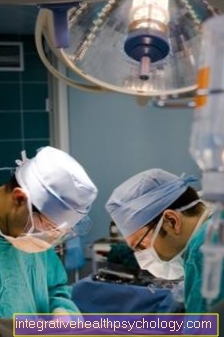


.jpg)
